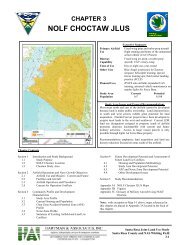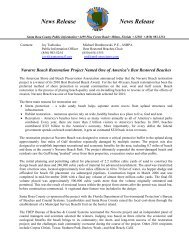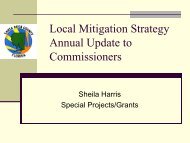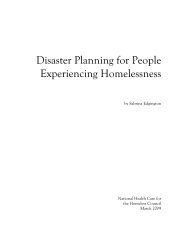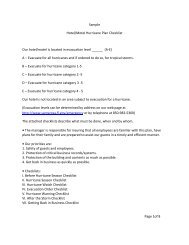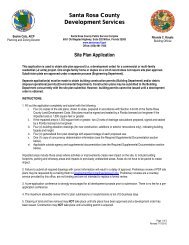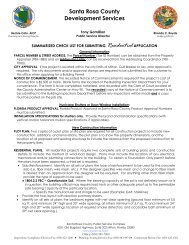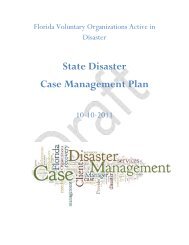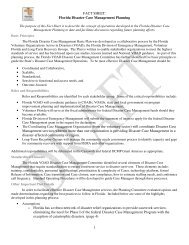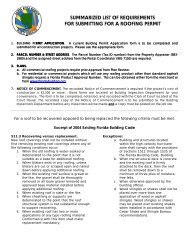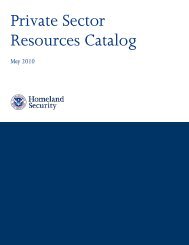Disaster - Santa Rosa County
Disaster - Santa Rosa County
Disaster - Santa Rosa County
You also want an ePaper? Increase the reach of your titles
YUMPU automatically turns print PDFs into web optimized ePapers that Google loves.
When evacuations<br />
Are ordered<br />
Hurricanes are the most common reason evacuations are ordered in <strong>Santa</strong> <strong>Rosa</strong> <strong>County</strong>, but orders can be<br />
issued at anytime for other types of disasters that will impact our area to insure the safety of residents and<br />
visitors alike. Evacuations are the movement of people to a safe area, from an area believed to be at risk, when<br />
emergency situations necessitate such action. Being told to evacuate is no doubt disruptive and inconvenient,<br />
but it is necessary to ensure the safety of you and your loved ones. When evacuation notices are given,<br />
residents and visitors must adhere to evacuation guidelines and immediately travel to a place outside of the<br />
evacuation zone.<br />
Should I stay or should I go<br />
Evacuation is a big choice and it brings with it many decisions to make. It is your<br />
responsibility to determine the risk for your family. Ask yourself these questions:<br />
Q: Do you live in a mobile or manufactured home<br />
A: Everyone who lives in a mobile or manufactured home should always evacuate.<br />
Q: Do you live in an evacuation zone<br />
A: If you don’t know your zone, you can look it up by typing in your address on our<br />
web page at www.santarosa.fl.gov/emergency. Click on “emergency management”<br />
and then “evacuation zones.” Be ready to follow the evacuation orders issued by<br />
officials for your zone.<br />
Q: Do you know where the public shelters are located<br />
A: <strong>Santa</strong> <strong>Rosa</strong> <strong>County</strong> does not have any hurricane shelters south of Interstate 10.<br />
This is because that area is the area of greatest risk. This is not only because of<br />
storm surge or wind damage but also the possibility of roads and areas becoming<br />
impassable or inaccessible for emergency services being able to reach you.<br />
Q: Do you have special needs or vulnerabilities (see page 14)<br />
A: Make sure you have a plan and if you need to go to the Special Needs Shelter, you<br />
must be pre-registered. You can register on-line, by phone or by mail.<br />
Q: Do you need to go to the Pet Friendly Shelter<br />
A: Make sure you have your pet pre-registered and understand the procedures for the<br />
pet friendly shelter. You must stay at the shelter with your pet!<br />
Q: Do you require transportation to a shelter<br />
A: Before an evacuation is ordered, pre-register by calling (850) 983-5360. If an<br />
evacuation has already been ordered, call (850) 983-INFO (4636) to arrange<br />
transportation.<br />
One of those decisions is whether to stay in <strong>Santa</strong> <strong>Rosa</strong> <strong>County</strong> or to drive hundreds<br />
of miles out of town. Evacuating tens of miles to shelter within the county has its<br />
advantages. You can avoid traffic jams and uncertainty that comes with hitting the<br />
crowded highways as other counties evacuate along with <strong>Santa</strong> <strong>Rosa</strong>. You can avoid<br />
going elsewhere in the state only to find the storm has shifted and now you are in harms<br />
way. You will also avoid the crowds when it comes time to return home.<br />
Should you decide to stay, plan ahead to find safe shelter. Ask family or friends if you<br />
can stay with them during a storm, find a hotel or motel in a safe area of the county or<br />
know where the closest shelter is and how to get there. Just make sure that if you stay,<br />
you are in a safe location for the type of event we are experiencing.<br />
When evacuating<br />
33<br />
Evacuate quickly and in daylight if<br />
possible.<br />
33<br />
Tell someone outside the warning<br />
area where you are going.<br />
33<br />
Follow the official evacuation<br />
routes.<br />
33<br />
Have a back-up plan in case you<br />
cannot reach your "safe-place."<br />
33<br />
Keep a full tank of gas in your car.<br />
33<br />
Be alert for washed out roads and<br />
bridges.<br />
33<br />
Do not drive in flooded areas. Stay<br />
away from downed power lines.<br />
33<br />
Consider the needs of children,<br />
elderly and pets.<br />
33<br />
Visit www.floridaevacuates.com for<br />
state-wide evacuation & shelter<br />
information.<br />
If you ignore<br />
an Evacuation<br />
Order<br />
12<br />
Evacuations<br />
You should be reminded that<br />
you will be jeopardizing your<br />
life and those of your family<br />
members. There might be a<br />
time period during the storm<br />
or incident that you will be on<br />
your own.<br />
Emergency and rescue<br />
personnel will not be able to<br />
respond to a call for assistance<br />
until after the danger of the<br />
storm has passed. After the<br />
storm, emergency and rescue<br />
personnel may not be able to<br />
immediately respond to your<br />
area because of damage, road<br />
debris and downed trees.




